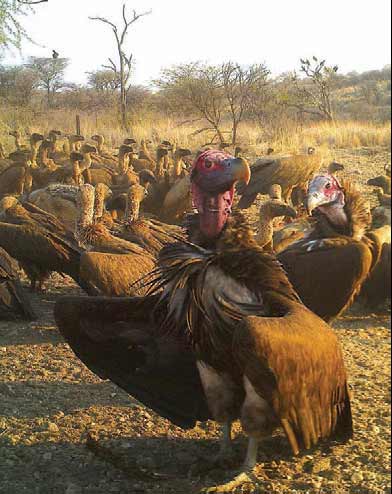![]() Endangered and Critically Endangered - all 7 vulture species that should
Endangered and Critically Endangered - all 7 vulture species that should
occur in Namibia
[Agra Ring -- May 2016]
 The farming community
has been alerted to a vulture population crisis over many years, and it
is surprising if a farmer does not grasp the extent of damage that can
be done with irregular and irresponsible handling, storage, use and clean-up
concerning any and all poisonous chemicals or pesticides on the farm.
The farming community
has been alerted to a vulture population crisis over many years, and it
is surprising if a farmer does not grasp the extent of damage that can
be done with irregular and irresponsible handling, storage, use and clean-up
concerning any and all poisonous chemicals or pesticides on the farm.
Poison and pesticides used on farms as livestock protection against predators have long been known as the most serious threat to populations of scavenging birds of prey. A single poison-laced large livestock carcass used as bait can kill a couple of hundred birds as primary victims. A jackal or hyena or leopard that has died from poison will kill from two up to 50 birds as secondary poison victims. A host of other species can also be poisoned, including among others eagles, storks and kites. Looking across Africa, vulture populations have decreased on average by 62% with some populations having shown a decline rate of 80% or more.
It is no secret that a percentage of farmers in Namibia use poison as part of their livestock farming methods. Farmers sometimes use certain known pesticides offlabel. Where there is crop farming, pesticide sales need to be carefully monitored and the managers, sales personnel and agricultural advisors at agricultural retailers, if they support and or advocate poison-use as a predator control, they place themselves and the farmers in a criminal position. Any pesticide knowingly sold for predator control is an illegal action both by the seller and ultimately be the user. Strychnine is a highly poisonous product that was sold under prescription of state veterinary officers. This activity stopped from around 2001, however some farms still have old but effective stored strychnine and continue to use it.
Vultures with their excellent eyesight, their exceptional use of air currents and their ability to consume a carcass in record time, seriously reduce the risks of pathogens being spread on farmlands. In large or small domestic livestock or wildlife production these birds also limit food for mammalian carnivores and thereby control rabies vector species such as feral dogs and jackal. An added value of vultures, is the fact that an alert land manager will recognize a livestock death in the veld by the behavior of these birds. This farmer-friendly fact has sadly been understood by poachers, who in the past couple of years have taken to contaminating carcasses even water points with poison. Poached and then poisoncontaminated carcasses of for example elephants have significantly added to the threat on vulture populations. Over 400 vultures were killed on a single elephant poached for ivory in 2013 in Zambezi Province. Further investigation found a host of elephant carcasses with vulture skeletons, many just over Namibia’s borders. How the poison gets into the hands of poachers will potentially track back to sales and storage of these hazardous products.
With all seven vulture species in Namibia endangered and critically endangered, being able to individually identify a vulture increases knowledge on these birds, and this can be applied to survival estimates of the various populations. Leg-rings were the traditional method of marking birds, but nowadays the use of colored wing-tags with large alpha-numeric coding has proved to be a much more reliable and visible method for vultures identification. Tracking, especially the use of satellite -tracking has emphasized the regional links and the need for collaborative action across nations.
Farmers
and land managers can be of great assistance to vultures and their current
and future conservation by being vigilant and by reporting. Reports of
tagged birds can be added to the Vultures Namibia data-base. Poisoned
birds that are still alive can often be saved with treatment. Reporting
dead vultures, no matter what the cause is essential for continued monitoring
of Namibia’s environment. But most importantly, taking a stand against
the irresponsible poisoning of our environment and our biodiversity will
be a long term solution for our own health and safety.
